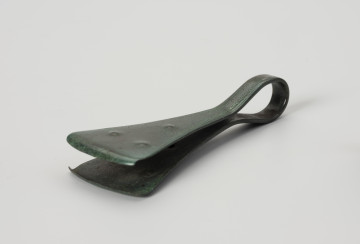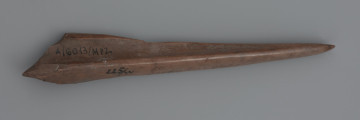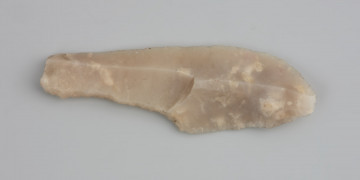
Tweezers
około 900 p.n.e. — 750 p.n.e.
National Museum in Szczecin
Part of the collection: Bronze Age
The plate is almost three thousand years old, made of clay and exquisitely fired. It is a very decorative specimen with a gently convex bottom, decorated with a slanting groove on edge. Its central part is filled with an impressive solar motif, symbolising the sun rays spreading in all directions. Two small holes visible just below the edge were used to hang the plate on a string or thong. The find comes from a pottery workshop of the Lusatian culture excavated in 1892 by Hugo Lemcke and Adolf Stubenrauch, two archaeology and history enthusiasts with broad cultural interests. Thanks to their efforts, a pottery kiln was uncovered and excavated with remains of more than a hundred vessels, some with traces of deformation after secondary burning in the fire. These researchers determined that the kiln, built of wood and lined with clay, collapsed during the firing process. The Late Bronze Age pottery from Bartkowo is the largest of the five known of its kind in Pomerania, and it certainly specialised in the production of beautifully decorated plates. These forms are the most characteristic products of the Lusatian culture from the 5th period of the Bronze Age (approx. 900-750 BC) in the Pomeranian-Brandenburg zone. Undoubtedly, they testify to the excellent skills of individual potters and the high level of pottery at that time.
Dorota Kozłowska
Author / creator
Dimensions
the entire object: height: 3 cm
Object type
plate
Technique
firing, carving, fluting, manual modelling
Material
ceramic
Origin / acquisition method
legal transfer
Creation time / dating
Creation / finding place
Owner
National Museum in Szczecin
Identification number
Location / status

około 900 p.n.e. — 750 p.n.e.
National Museum in Szczecin

9600 p.n.e. — 4100 p.n.e.
National Museum in Szczecin

11900 p.n.e. — 11000 p.n.e.
National Museum in Szczecin
DISCOVER this TOPIC
Castle Museum in Łańcut
DISCOVER this PATH
Educational path